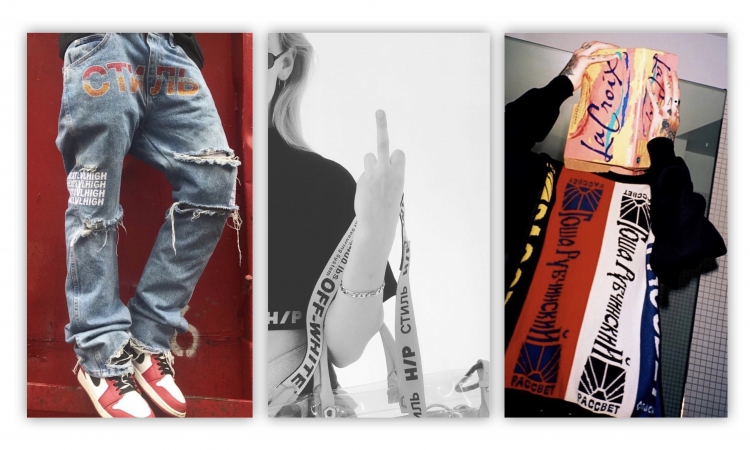"Cyrillics" Take Over

Adding large logos to clothing is one of the easiest ways to attract someone's attention, so it is not surprising that this trend has been repeatedly used by both luxury and mass-market brands. However, if the previously trendy Latin phrases and words used to run the show, "Cyrillic" has now taken over the spotlight in the fashion industry. Vogue called hoodies with Cyrillic inscriptions one of the main trends of last year. In 2017, they were released in local concept stores and boutiques and eventually made their way into the global fashion market. Clothing from every collection of the most famous Russian designer Gosha Rubchinsky has been sold all over the world in the last few years, and his name in Cyrillic is shown alongside the top brands such as Kappa and Fila. Even The New Yorker released their weekly magazine with a Cyrillic title in February 2017.
“Стиль”, “Гоша Рубчинский” and “Волк Оф Шэйм” are phrases now seen all over the globe, worn by fashionistas, celebrities, and displayed on the windows of famous brands. Who are the people hiding behind the Russian fashion wave and where did it all come from? In the fall of 2008 at the stadium in Sokolniki, Moscow, 600 spectators witnessed an unusual fashion show. Unexperienced young adults as models performed a "physical education lesson" in unique sweaters, sports pants, and T-shirts to the cult music from the '90s. This runway performance did not fit into the usual events of a traditional fashion show, but it was the moment when the world discovered Gosha Rubchinsky and his brand.
Over the past few years Rubchinksy has gained many loyal customers, from Russian hipsters to the top circles of European, American and Asian fashion lovers. The New East fashion was picked up by other designers like Latvian brand QooQoo which sells customers t-shirts with "Красава" and leggings with "Творю чудеса" ("Making Miracles"). Designer Yulia Yefimtchuk laconically decorated her shirts with the word "Эстетика" ("Estetics").
At the moment, the Cyrillic alphabet design is used not only by Russian brands but also by foreign ones who have caught the wave of success with Russian alphabet style. The French brand Vêtements released hoodies with the inscription "Земфира"("Zemfira"); the American brand "Urban Outfitters" produced sweatshirts with the inscription "Равноправие" ("Equality"); the British brand KTZ hoodies boldly ask "Do you really want to hurt me?" ("Вы действительно хотите сделать мне больно?")
An increasing amount of Cyrillic inscriptions have disseminated all over the globe, yet the question remains: why do people worship it? As the alphabet completely differs in terms of its letters and symbols, it is deemed exotic, and therefore creating the effect of novelty. Without its direct meaning, the text becomes a universal symbol that is recognizable everywhere regardless of its use and purpose. The journalist Nabila Jaffer in her essay "Is Nothing Sacred?" explains the significance of the alphabet in fashion: "We use symbols of foreign cultures as a sign of exoticism, sensuality or our disagreement with society." The same applies to unfamiliar languages on a t-shirt. In Russia in the 1990s, a t-shirt with a text in English (which might not have made sense or was misunderstood by the owner) served as a sign of openness to a new culture; similarly, in 2016, Western dandies started wearing t-shirts with the Cyrillic alphabet. Moreover, an important part of the interest in New East (and the consequent interest in Cyrillic) is associated with the Soviet legacy, which remains "comfortably" exotic for the Western observer.
Cyrillic text, devoid of its direct meaning, turns into a symbol open to interpretation. For the magazine The New Yorker, it can mean a complicated relationship between Russia and the US. For fans of Gosha Rubchinsky it means freedom and youth, but for customers of Urban Outfitters, it is strictly to show involvement in the top fashion trends. Some criticize logomania as a tool of the modern fashion industry, but others wear it as a sign of genuine interest in Russia. At the end of the day, what is selling remains in style for a reason.







